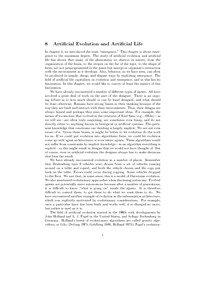Artificial Evolution and Artificial LifeRolf Pfeifer, Christian Scheier
|
 |
 Diese Seite wurde seit 2 Jahren inhaltlich nicht mehr aktualisiert.
Unter Umständen ist sie nicht mehr aktuell.
Diese Seite wurde seit 2 Jahren inhaltlich nicht mehr aktualisiert.
Unter Umständen ist sie nicht mehr aktuell.
 Zusammenfassungen
Zusammenfassungen

 This chapter is about emergence to the maximum degree. The study of artificial evolution and artificial life has shown that many of the phenomena we observe in nature, from the organization of the brain, to the stripes on the fur of the tiger, to the shape of ferns, are not preprogrammed in the genes but emerge in organism’s interaction
with the environment as it develops. Also, behavior, as we have seen, can often be produced in simple, cheap, and elegant ways by exploiting emergence. The field of artificial life capitalizes on evolution and emergence, and in this lies its fascination. In this chapter, we would like to convey at least the essence of this
fascination.
This chapter is about emergence to the maximum degree. The study of artificial evolution and artificial life has shown that many of the phenomena we observe in nature, from the organization of the brain, to the stripes on the fur of the tiger, to the shape of ferns, are not preprogrammed in the genes but emerge in organism’s interaction
with the environment as it develops. Also, behavior, as we have seen, can often be produced in simple, cheap, and elegant ways by exploiting emergence. The field of artificial life capitalizes on evolution and emergence, and in this lies its fascination. In this chapter, we would like to convey at least the essence of this
fascination. Dieser Text erwähnt ...
Dieser Text erwähnt ...
 Personen KB IB clear | Richard Dawkins | ||||||||||||||||||
 Begriffe KB IB clear | Baldwin-EffektBaldwin effect
, Emergenzemergence
,  Evolution Evolution evolution
, Evolutionstheorie von Darwin
, Genotyp
, evolution
, Evolutionstheorie von Darwin
, Genotyp
,  Hardware Hardware hardware
, Implizites Wissenimplicit knowledge
, hardware
, Implizites Wissenimplicit knowledge
,  Künstliches Leben (Artificial life) Künstliches Leben (Artificial life) Artificial life
, Artificial life
,  Leben Leben life
, Phänotyp
, life
, Phänotyp
,  Wissen
, Wissen
,  Zelle Zelle cell cell
| ||||||||||||||||||
 Bücher |
|
 Dieser Text erwähnt vermutlich nicht ...
Dieser Text erwähnt vermutlich nicht ... 
 Nicht erwähnte Begriffe | Explizites Wissen, Wissensmanagement, Zellmembran |
 Tagcloud
Tagcloud
 Zitationsgraph (Beta-Test mit vis.js)
Zitationsgraph (Beta-Test mit vis.js)
 Volltext dieses Dokuments
Volltext dieses Dokuments
 | Artificial Evolution and Artificial Life: Kapitel als Volltext ohne Abbildungen und Tabellen ( : :  , 181 kByte) , 181 kByte) |
 Anderswo suchen
Anderswo suchen 
 Beat und dieser Text
Beat und dieser Text
Beat war Co-Leiter des ICT-Kompetenzzentrums TOP während er Dieser Text ins Biblionetz aufgenommen hat. Die bisher letzte Bearbeitung erfolgte während seiner Zeit am Institut für Medien und Schule. Beat besitzt kein physisches, aber ein digitales Exemplar. (das er aber aus Urheberrechtsgründen nicht einfach weitergeben darf). Es gibt bisher nur wenige Objekte im Biblionetz, die dieses Werk zitieren.









 Biblionetz-History
Biblionetz-History